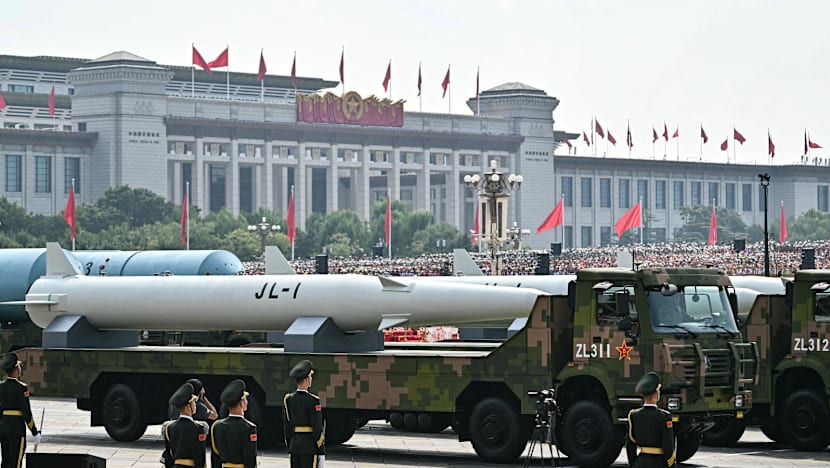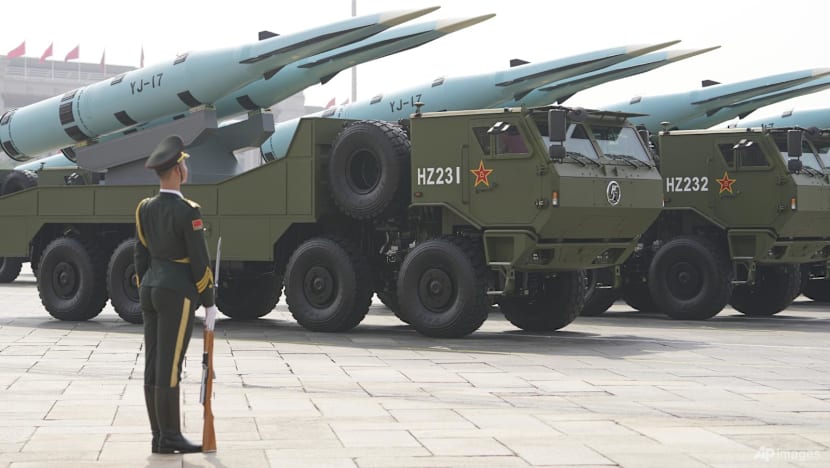Commentary: What China’s weapons parade says about its military might
From new nuclear missiles to counter-drone systems, China flexed its technological muscle to the world, says defence writer Mike Yeo.

The JL-1 first generation nuclear submarine-launched ballistic missile is seen during a military parade marking the 80th anniversary of victory over Japan and the end of World War II, in Beijing’s Tiananmen Square on Sep 3, 2025. (Photo: AFP/Pedro Pardo)

This audio is generated by an AI tool.
MELBOURNE: A military parade is always a carefully orchestrated show of might, and China’s parade on Sep 3 to commemorate the 80th anniversary of the end of World War II offered the world a good look at some of its latest weapons.
The message it sent was clear: The People’s Liberation Army (PLA) is a high-tech force capable of shaping and prevailing on a modern battlefield, to defend China’s interests and ambitions for a new world order.
Several new systems were displayed for the first time in public, including new nuclear missiles for its nuclear triad, hypersonic missiles, naval lasers and counter-drone systems.
It also showcased a plethora of unmanned systems, including new stealth drones for air combat, “loyal wingmen” (networked operations alongside manned aircraft), and two different unmanned submarines for a variety of missions including mine clearance.
While there were scant details about the performance and other capabilities of the new weapons, there are conclusions that could be drawn from what we have seen about China’s intentions and capabilities.
A SURVIVABLE NUCLEAR DETERRENT
This was the first time China publicly displayed and confirmed its full nuclear triad – with land-based, air-launched and seaborne nuclear weapons.
A triad ensures parts of a nation’s nuclear deterrent could survive a surprise first strike and remain viable for a counterattack. Having a credible “second strike capability” would deter adversaries from trying a disabling first strike to begin with.
China paraded five different types of nuclear missiles: the land-based DF-5C, DF-31BJ and DF-61 Inter-Continental Ballistic Missiles (ICBMs), the JL-1 Air-Launched Ballistic Missile (ALBM) and JL-3 Submarine Launched Ballistic Missile (SLBM). Of these, only the JL-3 has previously been shown at a Chinese military parade, as well as earlier versions of the DF-5 and DF-31.
However, a survivable nuclear deterrent goes beyond having a counterstrike capability.
It also requires an early warning system to provide sufficient heads-up of an incoming attack. China is continuing its investments in this area, having built a network of ground-based early warning radars and put satellites into orbit, although the number of early warning satellites is still relatively small.
Survivability also means the ability to always have at least one ballistic missile submarine out at sea to ensure not all can be targeted in port.
And China has ticked this box since 2023, according to the annual China Military Power report published by the US Department of Defense. It is also building a new class of ballistic missile submarine to replace its current fleet of Type 094 boats, which are reportedly not quiet enough by modern standards.
China has also fortified the base of the H-6N bombers that can carry the JL-1 by carving out a large facility inside a mountain to park the bombers at their base in Neixiang-Ma’ao in Henan Province, although it still lacks sufficient tanker aircraft to keep the bombers in the air for prolonged periods.
AN ARRAY OF HYPERSONIC MISSILES
It was also notable that there were hardly any conventionally-armed ballistic missiles at this year’s parade, when they used to figure prominently. Instead, China showcased a variety of land- and ship-based missiles that utilised hypersonic boost-glide warheads.

Unlike ballistic missiles that fly in a fairly predictable arc in a fixed direction from launch, boost-glide weapons are much more manoeuvrable. They can make adjustments mid-flight and can approach an assigned target from any point of the compass, making it harder to detect, track and intercept.
Boost glide weapons can reach hypersonic speeds (approximately five times the speed of sound) of ballistic missiles but retain the flexibility of cruise missiles, which fly at high subsonic speeds (just below the speed of sound).
According to the 2024 report on China’s military power released annually by the US Department of Defense, the PLA Rocket Force has an arsenal of 3,500 longer-ranged boost-glide weapons, ballistic and cruise missiles, in addition to many more similar, shorter-ranged missiles operated by the PLA Air Force and Navy.
Hypersonic missiles will be key to striking targets such as enemy bases, logistics and support hubs in the event of a conflict.
Any future conflict will be a war of attrition between stockpiles of attacking missiles and defending interceptors. This was demonstrated earlier this year, with Israel depleting its stocks of Arrow ballistic missile interceptors and the US going through its own stocks of missile interceptors at an “alarming rate” against drones and missiles fired by Iran and Yemen’s Houthis.
COUNTER-DRONE SYSTEMS
China also displayed something that militaries have been scrambling for: counter-drone systems.
Experts have been warning about a nightmare scenario of relatively cheap commercial-grade drones striking high-value military assets. On Jun 1, Ukraine demonstrated that this was now possible, when it launched hundreds of drones from deep inside Russia, attacking airbases far from the frontlines and destroying or damaging an estimated 30 Russian military aircraft.
Current air defence systems have been ineffective in detecting and destroying such drones, or are unsustainable given the use of expensive missiles to defeat cheap drones.
At the parade, the PLA rolled out its mobile gun, combined gun-missile, microwave energy and laser counter-drone systems. The threat of drone swarms was clearly on the minds of Chinese military planners – the gun and missile system and microwave energy systems look specifically designed to deal with such attacks.
The former carried an autocannon along with two banks of missile canisters fitted on a rotating weapons mount. One bank of missiles on the vehicle on display was packing a total of 48 small missile canisters. This means that it could potentially carry a whopping 96 missiles.
This set-up appears similar to the FK-3000 system that was displayed as far back as 2022, at the Zhuhai Airshow. This means that it was conceptualised by PLA planners or China’s defence industry even before Ukraine proved the concept on the battlefield.
Given that China is one of the world’s foremost manufacturers of small commercial drones, the early recognition of the potential battlefield challenge and delivering solutions even as others are starting to play catch-up is perhaps unsurprising.
The parade underscored how much China has modernised its military and is the world leader in areas like hypersonic weapons. What remains to be worked on is for the various branches of the PLA to work together as a cohesive, integrated force, and while most analysts agree that it is not there yet, it is certainly moving in this direction.
Mike Yeo is the Indo-Pacific Bureau Chief for defence media outlet Breaking Defense. He has more than a decade of experience as a defence journalist, specialising in regional defence and security matters.



















